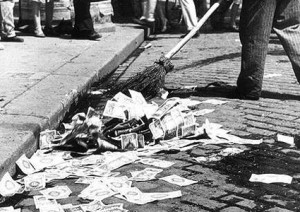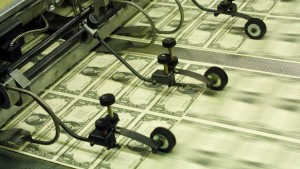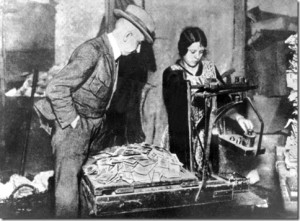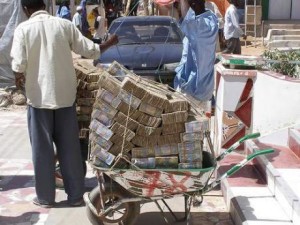As if watching the nation race towards economic catastrophe wasn’t enough to get you to start hoarding and organizing, below are a few scary times from the past. Always remember that we could be there; and might follow suit. So before you dig into a few select case studies check out this great article from Forbes Magazine (reference below) of quantitative easing or the purposeful devaluation of currency for any number of rationalized excuses:
The Federal Reserve’s seemingly endless program of quantitative easing (QE) begun under Ben Bernanke, and continuing at a slightly slower pace under Janet Yellen, has some of the punditry and much of the electorate up in arms. With good reason.
Implicit in quantitative easing is the horribly obtuse notion that central banks can produce real economic growth through their monetary machinations. If only life were so simple.
Back in the world of the reasonable, the sole purpose of money is as a stable measure of value that facilitates the exchange of goods and investment. Quantitative easing, by its very name, involves the corruption of money’s sole purpose as a stable medium of exchange.
In that case it must be stressed that QE has in no way boosted growth. The latter results from investment in new and existing commercial concepts, and for destabilizing the value of money, QE works against the very investment that would drive economic growth.
Worse, the imposition of QE can only take place when the White House and Treasury support such a move, the latter support speaks to a desire on the part of the White House and Treasury to devalue the unit of account (the dollar), and as investors are buying future dollar income streams when they invest, QE acts as an investment deterrent.
Looked at in terms of financial markets, QE similarly has not been good for stocks. Indeed, stocks have been rallying ever since word emerged from the Fed two years ago about an eventual end to the program, and as markets always price in the future, it’s apparent that investors would logically prefer an end to what which logically does not, and cannot, work.
Taking this further, implicit in the suggestion that QE has been good for stocks is the view that the creation of liquidity in search of yield will force buyers into the stock market. That’s fine, but for an investor to buy, another investor must be willing to sell. The better question to ask vis-à-vis QE is just how much healthier the stock markets would be absent this investment-sapping ball-and-chain conceived by the ever-fraudulent economics profession.
Another persistent view about QE that’s popular even inside the crowd that is properly skeptical of it is the notion that QE amounts to “money printing.” It does not. To be clear, the Federal Reserve has not been printing money. It hasn’t needed to, and that’s where the horrors of the Fed’s machinations become most apparent.
To see why, we have to address the Fed’s policy of paying interest on bank reserves. At present the Fed is paying banks 25 basis points for their “excess” reserves.
To the Monetarist School thinkers among us, they see IOR as the mechanism whereby the Fed keeps money tight, and in their perfect world the Fed would not be paying banks for access to their funds. They’re right that the Fed should not be competing for excess reserves, but they’re wrong about the impact of doing so.
The willingness of banks to lend money to the Fed for 25 basis points firstly speaks to the low cost of overnight credit that banks charge each other. At present banks borrow from each other on an overnight basis for roughly 15 basis points. This makes lending to the Fed relatively attractive. Still, this does not constitute “tight money.” It doesn’t simply because if the Fed ever succeeds in tightening beyond what the markets want, other sources of dollar credit here and around the world will make up for any dollar shortage.
Considering banks themselves, they never realistically have “excess” funds. Instead, banks long on cash are constantly lending to banks in need of short-term cash (the “repo” market); the lending taking place in return for the borrower showing quality collateral that merits the overnight loan. In this case, rather than lend their excess to each other at 15 basis points, the banks are lending it to the Fed at a higher rate of 25 basis points.
Still, it must be stressed yet again that this in no way signals “tight money.” What it in fact tells us is that banks don’t see quality lending opportunities, and it also signals that demand for credit is very low. This is basic economics. Banks would much rather lend at higher rates of interest to all manner of borrowers in order to earn more than 25 basis points on their excess reserves, but with demand for credit once again low, banks are lending to the Fed.
The lesson here is that despite what is broadly presumed by economists and the punditry, the Fed can’t force money into the economy, nor can it increase “money supply.” Money supply is demand determined, and with the economy still relatively weak, there’s very little demand for the dollar credit that’s been expanded by Fed purchases of bank assets.
What about the supposed “money printing” by the Fed? There’s once again no such thing occurring. Instead, the Fed is able to engage in its program of quantitative easing thanks to its 25 basis point payments for bank reserves. With the funds borrowed from banks, the Fed has the means to purchase all manner of Treasuries and mortgage bonds.
Of course that’s yet another reason why the Fed’s QE program is so economically harmful. To understand why it has to be accepted that “recessions,” painful as they are, are a sign that an economy is on the mend, that markets are correcting all the malinvestment in bad business concepts and labor misuses that brought on the pain to begin with. Recessions by their very name signal a major rebound if left alone, precisely because they’re fixing what hasn’t worked.
Considering the Fed’s allocation of $4 trillion of credit borrowed from banks, the horror isn’t “money printing” that not’s occurring, rather it’s the Fed spending $4 trillion to prop up investment errors that, if allowed to reach their natural level, would force a reorientation of capital to higher, more economically enhancing uses. To be blunt, the fact that the Fed is paying interest on reserves means that it is explicitly robbing us of an economic recovery by virtue of it allocating capital to bad, economy-sapping ideas that would otherwise be starved of it were the Fed’s top officials not so tragically infected by the central-planning gene.
So no, the Fed is not printing money. In fact, the Fed is doing much worse than that. In allocating $4 trillion borrowed from banks, it’s supporting the very government spending and housing consumption that got us into trouble to begin with. More to the point, the Fed is financing ongoing economic hardship through its expanded borrowing of bank reserves.
Fun Thoughts
Now for those of us that are optimists here are the official number. During Fiscal Year (FY) 2014, the Bureau of Engraving and Printing delivered approximately 24.8 million notes a day with a face value of approximately $560 million. Over 90 percent of the notes that the BEP delivers each year are used to replace notes already in, or taken out of circulation. But that number does not take into account the Fed owning 65% more of its own debt than China, or the Fed owning 8.9% of total public dept. The Federal Reserve’s balance sheet also shows the Federal Reserve itself is by far the largest holder of U.S. Treasury bonds. The U.S. is also steadily approaching 18 trillion in debt (probably over 18 by the time you read this), or over 58 thousand per U.S. citizen.
Weimar Republic
Following WWI Germany was obliged to pay out 50 billion marks stipulated in the A and B Bonds. The actual total payout from 1920 to 1931 (when payments were suspended indefinitely) was 20 billion German gold marks, worth about $5 billion US dollars or £1 billion British pounds. 12.5 billion was cash that came mostly from loans from New York bankers. The rest was goods like coal and chemicals, or from assets like railway equipment. The reparations bill was fixed in 1921 on the basis of a German capacity to pay, not on the basis of Allied claims. The highly publicized rhetoric of 1919 about paying for all the damages and all the veterans’ benefits was irrelevant for the total, but it did determine how the recipients spent their share. Germany owed reparations chiefly to France, Britain, Italy and Belgium; the US Treasury received $100 million.
In the early post-war years, inflation was growing at an alarming rate, but the government simply printed more and more banknotes to pay the bills. By 1923, the Republic claimed it could no longer afford the reparations payments required by the Versailles Treaty, and the government defaulted on some payments. In response, French and Belgian troops occupied the Ruhr region, Germany’s most productive industrial region at the time, taking control of most mining and manufacturing companies in January 1923. Strikes were called, and passive resistance was encouraged. These strikes lasted eight months, further damaging the economy and the social life.
The strike prevented some goods from being produced, but one industrialist, Hugo Stinnes, was able to create a vast empire out of bankrupt companies. Because the production costs in Germany were falling almost hourly, the prices for German products were unbeatable. Stinnes made sure that he was paid in dollars, which meant that by mid-1923, his industrial empire was worth more than the entire German economy. By the end of the year, over two hundred factories were working full-time to produce paper for the spiraling bank note production. Stinnes’ empire collapsed when the government-sponsored inflation was stopped in November 1923.
Since striking workers were paid benefits by the state, much additional currency was printed, fuelling a period of hyperinflation. The 1920s German inflation started when Germany had no goods to trade. The government printed money to deal with the crisis; this meant payments within Germany were made with worthless paper money, and helped formerly great industrialists to pay back their own loans. This also led to pay raises for workers and for businessmen who wanted to profit from it. Circulation of money rocketed, and soon banknotes were being overprinted to a thousand times their nominal value and every town produced its own promissory notes; many banks & industrial firms did the same.
The value of the Papiermark had declined from 4.2 Marks per U.S. dollar in 1914 to one million per dollar by August 1923. This led to further criticism of the Republic. On 15 November 1923, a new currency, the Rentenmark, was introduced at the rate of one trillion (1,000,000,000,000) Papiermark for one Rentenmark, an action known as redenomination. At that time, one U.S. dollar was equal to 4.2 Rentenmark. Reparation payments were resumed, and the Ruhr was returned to Germany under the Locarno Treaties, which defined the borders between Germany, France, and Belgium.
Argentina
Argentina went through steady inflation from 1975 to 1991. Democratically elected on December 10, 1983, President Alfonsin inherited a foreign debt crisis and record budget deficits, resulting in US$43 billion foreign debt, with Argentina’s entire trade surplus going to debt service. The situation worsened markedly on “Black Tuesday,” February 7, 1989, when the U.S. dollar gained around 40% against the austral. As a result, the World Bank recalled a large tranche of loans, sending the austral into the void and igniting hyperinflation by Election Day, May 14, 1989. By June 1989 social unrest was widespread and included instances of rioting and looting of supermarkets. At the beginning of 1975, the highest denomination was 1,000 pesos. In late 1976, the highest denomination was 5,000 pesos. In early 1979, the highest denomination was 10,000 pesos. By the end of 1981, the highest denomination was 1,000,000 pesos. In the 1983 currency reform, 1 peso argentino was exchanged for 10,000 pesos. In the 1985 currency reform, 1 austral was exchanged for 1,000 pesos argentinos. In the 1992 currency reform, 1 new peso was exchanged for 10,000 australes. The overall impact of hyperinflation: 1 (1992) peso = 100,000,000,000 pre-1983 pesos. Annual inflation hit 12,000% in 1989.
Austria
In 1922, inflation in Austria reached 1426%, and from 1914 to January 1923, the consumer price index rose by a factor of 11836, with the highest banknote in denominations of 500,000 krones.
Political ineptitude in Post WWI Austria comprised political expedience and Socialist benevolence. Thus, essentially all State enterprises ran at a loss and the number of State employees in Vienna, the capital of the post WWI republic was greater than that of the earlier monarchy, even though they served a population base nearly eight times smaller.
Observing the Austrian response to developing hyperinflation, fueled by selfishness and political ineptitude, including the hoarding of food and the speculation in foreign currencies, Owen S. Phillpotts, the Commercial Secretary at the British Legation in Vienna wrote: “The Austrians are like men on a ship who cannot manage it, and are continually signaling for help. While waiting, however, most of them begin to cut rafts, each for himself, out of the sides and decks. The ship has not yet sunk despite the leaks so caused, and those who have acquired stores of wood in this way may use them to cook their food, while the more seamanlike look on cold and hungry. The population lack courage and energy as well as patriotism”.
Zimbabwe
Hyperinflation in Zimbabwe was one of the few instances that resulted in the abandonment of the local currency. At independence in 1980, the Zimbabwe dollar (ZWD) was worth about USD 1.25. Afterwards, however, rampant inflation and the collapse of the economy severely devalued the currency. Inflation was steady before Robert Mugabe in 1998 began a program of land reforms that primarily focused on returning land taken from black natives during colonialization which led to disrupted food production and caused revenues from exports of food to plummet and foreign direct investment declined. The result was that to pay its expenditures Mugabe’s government and Gideon Gono’s Reserve Bank printed more and more notes with higher face values.
Hyperinflation began early in the 21st-century, reaching 624% in 2004. It fell back to low triple digits before surging to a new high of 1,730% in 2006. The Reserve Bank of Zimbabwe revalued on 1 August 2006 at a ratio of 1 000 ZWD to each second dollar (ZWN), but year-to-year inflation rose by June 2007 to 11,000% (versus an earlier estimate of 9,000%). Larger denominations were progressively issued:
Inflation by 16 July officially surged to 2,200,000% with some analysts estimating figures surpassing 9,000,000 percent. As of 22 July 2008 the value of the ZWN fell to approximately 688 billion per 1 USD, or 688 trillion pre-August 2006 Zimbabwean dollars.
On 1 August 2008, the Zimbabwe dollar was redenominated at the ratio of 1010 ZWN to each third dollar (ZWR). On 19 August 2008, official figures announced for June estimated the inflation over 11,250,000%. Zimbabwe’s annual inflation was 231,000,000% in July (prices doubling every 17.3 days). By October 2008 Zimbabwe was mired in hyperinflation with wages falling far behind inflation. In this dysfunctional economy hospitals and schools had chronic staffing problems, because many nurses and teachers could not afford bus fare to work. Most of the capital of Harare was without water because the authorities had stopped paying the bills to buy and transport the treatment chemicals. Desperate for foreign currency to keep the government functioning, Zimbabwe’s central bank governor, Gideon Gono, sent runners into the streets with suitcases of Zimbabwean dollars to buy up American dollars and South African rand. For periods after July 2008, no official inflation statistics were released. Prof. Steve H. Hanke overcame the problem by estimating inflation rates after July 2008 and publishing the Hanke Hyperinflation Index for Zimbabwe. Prof. Hanke’s HHIZ measure indicated that the inflation peaked at an annual rate of 89.7 sextillion percent (89,700,000,000,000,000,000,000%) in mid-November 2008. The peak monthly rate was 79.6 billion percent, which is equivalent to a 98% daily rate, or around 7× 10108 percent yearly rate. At that rate, prices were doubling every 24.7 hours. Note that many of these figures should be considered mostly theoretic, since the hyperinflation did not proceed at that rate a whole year.
At its November 2008 peak, Zimbabwe’s rate of inflation approached, but failed to surpass, Hungary’s July 1946 world record. On 2 February 2009, the dollar was redenominated for the fourth time at the ratio of 1012 ZWR to 1 ZWL, only three weeks after the $100 trillion banknote was issued on 16 January, but hyperinflation waned by then as official inflation rates in USD were announced and foreign transactions were legalized, and on 12 April the dollar was abandoned in favor of using only foreign currencies. The overall impact of hyperinflation was 1 ZWL = 1025 ZWD.
For more goodness simply search Wikipedia for hyperinflation.
Jon
http://www.forbes.com/sites/johntamny/2014/03/09/the-fed-is-not-printing-money-its-doing-something-much-worse/
Also reference Wikipedia for the examples of hyperinflation
http://cnsnews.com/news/article/terence-p-jeffrey/fed-owns-64-more-us-government-debt-china







Leave a Reply